6 books about Atmosphere
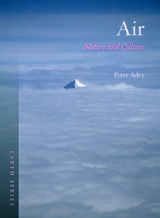
Air
Nature and Culture
Peter Adey
Reaktion Books, 2014
Outside of yoga class, we don’t pay too much attention to the air we take in every day. Long one of the essential elements to life on earth—from the atmospheric composition that gave life to the coal-forming forests some three hundred million years ago to the air that fuels our most important technologies today—we think little of its incredible properties. In this innovative cultural and scientific history, Peter Adey takes stock of the great ocean of air that surrounds us, exploring our attempts to understand, engineer, make sense of, and find meaning in it.
Adey examines how humans have managed and manipulated air as a natural resource and, in doing so, have been taken to the limits of survival, brought to high-altitude mountain peaks, subterranean worlds, and the troughs of new moral depths. Going beyond how vital air has been to our philosophical, scientific, and technological pursuits, he also reveals the way that the artistic and literary imagination has been lifted through air and how, in air, cultures have learned to express and inspire each other. Combining established figures such as Joseph Priestley, John Scott Haldane, and Marie Curie with unlikely individuals from painting, literature, and poetry, this richly illustrated book unlocks new perspectives into the science and culture of this pervasive but unnoticed substance.
Adey examines how humans have managed and manipulated air as a natural resource and, in doing so, have been taken to the limits of survival, brought to high-altitude mountain peaks, subterranean worlds, and the troughs of new moral depths. Going beyond how vital air has been to our philosophical, scientific, and technological pursuits, he also reveals the way that the artistic and literary imagination has been lifted through air and how, in air, cultures have learned to express and inspire each other. Combining established figures such as Joseph Priestley, John Scott Haldane, and Marie Curie with unlikely individuals from painting, literature, and poetry, this richly illustrated book unlocks new perspectives into the science and culture of this pervasive but unnoticed substance.
[more]
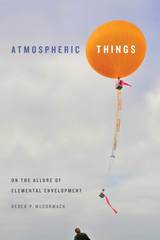
Atmospheric Things
On the Allure of Elemental Envelopment
Derek P. McCormack
Duke University Press, 2018
In Atmospheric Things Derek P. McCormack explores how atmospheres are imagined, understood, and experienced through experiments with a deceptively simple object: the balloon. Since the invention of balloon flight in the late eighteenth century, balloons have drawn crowds at fairs and expositions, inspired the visions of artists and writers, and driven technological development from meteorology to military surveillance. By foregrounding the distinctive properties of the balloon, McCormack reveals its remarkable capacity to disclose the affective and meteorological dimensions of atmospheres. Drawing together different senses of the object, the elements, and experience, McCormack uses the balloon to show how practices and technologies of envelopment allow atmospheres to be generated, made meaningful, and modified. He traces the alluring entanglement of envelopment in artistic, political, and technological projects, from the 2009 Pixar movie Up and Andy Warhol’s 1966 installation Silver Clouds to the use of propaganda balloons during the Cold War and Google's experiments with delivering internet access with stratospheric balloons. In so doing, McCormack offers new ways to conceive of, sense, and value the atmospheres in which life is immersed.
[more]
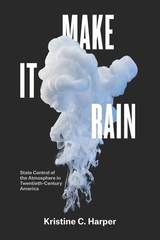
Make It Rain
State Control of the Atmosphere in Twentieth-Century America
Kristine C. Harper
University of Chicago Press, 2017
Weather control. Juxtaposing those two words is enough to raise eyebrows in a world where even the best weather models still fail to nail every forecast, and when the effects of climate change on sea level height, seasonal averages of weather phenomena, and biological behavior are being watched with interest by all, regardless of political or scientific persuasion. But between the late nineteenth century—when the United States first funded an attempt to “shock” rain out of clouds—and the late 1940s, rainmaking (as it had been known) became weather control. And then things got out of control.
In Make It Rain, Kristine C. Harper tells the long and somewhat ludicrous history of state-funded attempts to manage, manipulate, and deploy the weather in America. Harper shows that governments from the federal to the local became helplessly captivated by the idea that weather control could promote agriculture, health, industrial output, and economic growth at home, or even be used as a military weapon and diplomatic tool abroad. Clear fog for landing aircraft? There’s a project for that. Gentle rain for strawberries? Let’s do it! Enhanced snowpacks for hydroelectric utilities? Check. The heyday of these weather control programs came during the Cold War, as the atmosphere came to be seen as something to be defended, weaponized, and manipulated. Yet Harper demonstrates that today there are clear implications for our attempts to solve the problems of climate change.
In Make It Rain, Kristine C. Harper tells the long and somewhat ludicrous history of state-funded attempts to manage, manipulate, and deploy the weather in America. Harper shows that governments from the federal to the local became helplessly captivated by the idea that weather control could promote agriculture, health, industrial output, and economic growth at home, or even be used as a military weapon and diplomatic tool abroad. Clear fog for landing aircraft? There’s a project for that. Gentle rain for strawberries? Let’s do it! Enhanced snowpacks for hydroelectric utilities? Check. The heyday of these weather control programs came during the Cold War, as the atmosphere came to be seen as something to be defended, weaponized, and manipulated. Yet Harper demonstrates that today there are clear implications for our attempts to solve the problems of climate change.
[more]

Picturing the Atmosphere
Photography and the Advancement of Atmospheric Science
Terrence R. Nathan
American Meteorological Society, 2021
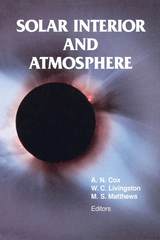
Solar Interior and Atmosphere
Edited by A. N. Cox, W. C. Livingston, and M. S. Matthews
University of Arizona Press, 1991
Observational data derived from the world’s largest solar telescopes are correlated with theoretical discussions in nuclear and atomic physics by contributors representing a wide range of interests in solar research.
[more]
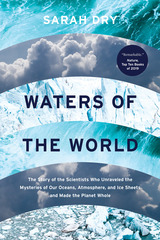
Waters of the World
The Story of the Scientists Who Unraveled the Mysteries of Our Oceans, Atmosphere, and Ice Sheets and Made the Planet Whole
Sarah Dry
University of Chicago Press, 2019
The compelling and adventurous stories of seven pioneering scientists who were at the forefront of what we now call climate science.
From the glaciers of the Alps to the towering cumulonimbus clouds of the Caribbean and the unexpectedly chaotic flows of the North Atlantic, Waters of the World is a tour through 150 years of the history of a significant but underappreciated idea: that the Earth has a global climate system made up of interconnected parts, constantly changing on all scales of both time and space. A prerequisite for the discovery of global warming and climate change, this idea was forged by scientists studying water in its myriad forms. This is their story.
Linking the history of the planet with the lives of those who studied it, Sarah Dry follows the remarkable scientists who summited volcanic peaks to peer through an atmosphere’s worth of water vapor, cored mile-thick ice sheets to uncover the Earth’s ancient climate history, and flew inside storm clouds to understand how small changes in energy can produce both massive storms and the general circulation of the Earth’s atmosphere. Each toiled on his or her own corner of the planetary puzzle. Gradually, their cumulative discoveries coalesced into a unified working theory of our planet’s climate.
We now call this field climate science, and in recent years it has provoked great passions, anxieties, and warnings. But no less than the object of its study, the science of water and climate is—and always has been—evolving. By revealing the complexity of this history, Waters of the World delivers a better understanding of our planet’s climate at a time when we need it the most.
From the glaciers of the Alps to the towering cumulonimbus clouds of the Caribbean and the unexpectedly chaotic flows of the North Atlantic, Waters of the World is a tour through 150 years of the history of a significant but underappreciated idea: that the Earth has a global climate system made up of interconnected parts, constantly changing on all scales of both time and space. A prerequisite for the discovery of global warming and climate change, this idea was forged by scientists studying water in its myriad forms. This is their story.
Linking the history of the planet with the lives of those who studied it, Sarah Dry follows the remarkable scientists who summited volcanic peaks to peer through an atmosphere’s worth of water vapor, cored mile-thick ice sheets to uncover the Earth’s ancient climate history, and flew inside storm clouds to understand how small changes in energy can produce both massive storms and the general circulation of the Earth’s atmosphere. Each toiled on his or her own corner of the planetary puzzle. Gradually, their cumulative discoveries coalesced into a unified working theory of our planet’s climate.
We now call this field climate science, and in recent years it has provoked great passions, anxieties, and warnings. But no less than the object of its study, the science of water and climate is—and always has been—evolving. By revealing the complexity of this history, Waters of the World delivers a better understanding of our planet’s climate at a time when we need it the most.
[more]
READERS
Browse our collection.
PUBLISHERS
See BiblioVault's publisher services.
STUDENT SERVICES
Files for college accessibility offices.
UChicago Accessibility Resources
home | accessibility | search | about | contact us
BiblioVault ® 2001 - 2024
The University of Chicago Press









